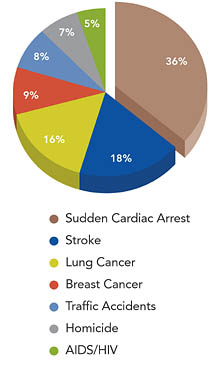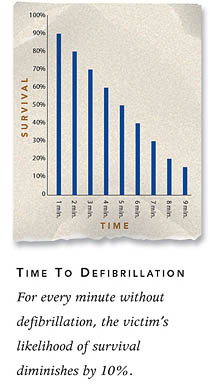
|
 |
 Sudden
Cardiac Arrest Sudden
Cardiac Arrest
 Did you know? Did you know?
Did
you know that sudden cardiac arrest, also called a massive heart attack,
can strike anyone, anywhere, at anytime? When AEDs are available and used
quickly, most cardiac arrest victims survive. Cardiac Science is dedicated
to providing solutions to help you save lives.
What is Sudden Cardiac Arrest?
Sudden cardiac
arrest, commonly known as massive heart attack, kills more than 450,000
Americans each year, making it the #1 health care problem and leading
cause of death in the United States. This is equivalent to the entire
population of the cities of Sacramento, Kansas City, or Atlanta being
wiped out in one year, or nearly one death every minute. Breast cancer,
stroke, and AIDS claim fewer lives combined.
 In SCA, the heart suddenly stops beating
normally. The electrical impulses that control the rhythm of the heart
become so disorganized that the heart begins to quiver and can no longer
effectively pump oxygenated blood to the brain and the body's vital
organs, and death occurs within minutes. CPR cannot reverse ventricular
fibrillation (VF), the chaotic cardiac rhythm most often seen in SCA
victims; prompt external defibrillation is the only known effective
treatment to halt sudden cardiac arrest. In SCA, the heart suddenly stops beating
normally. The electrical impulses that control the rhythm of the heart
become so disorganized that the heart begins to quiver and can no longer
effectively pump oxygenated blood to the brain and the body's vital
organs, and death occurs within minutes. CPR cannot reverse ventricular
fibrillation (VF), the chaotic cardiac rhythm most often seen in SCA
victims; prompt external defibrillation is the only known effective
treatment to halt sudden cardiac arrest.
What Causes
Sudden Cardiac Arrest?
The most common cause of SCA is ventricular
fibrillation -- a lethal arrhythmia characterized by rapid, chaotic
contractions of the heart. While in ventricular fibrillation, the heart is
unable to pump life-sustaining oxygenated blood to vital parts of the
body, particularly the brain.
According to the American Heart
Association® (AHA), some factors contributing to SCA include:
- Coronary Heart Disease
- Electrocution
- Drowning
- Choking
- Trauma
- Illegal drug use
Death from SCA is sudden and unexpected,
occurring instantly or shortly after the onset of symptoms. While there
are many contributing factors, SCA can strike people anytime, anywhere,
and at any age. Even a seemingly healthy person can suffer cardiac arrest
without warning. According to the American Heart Association, as many as
50% of SCA victims have no prior indication of heart disease - their first
symptom is cardiac arrest. For those with a known history of heart
attacks, the chance of sudden cardiac death is 4-6 times greater than that
of the general population.
Why is Early
Defibrillation Important?
In many cases, SCA can be reversed with
early defibrillation -- the use of a defibrillator to shock the heart back
into normal rhythm by means of an electric current. To be most effective,
defibrillation must occur as soon as possible after the onset of SCA.
- According to the AHA, each minute of delay in delivering a
defibrillation shock to a cardiac arrest victim reduces the chances of
survival by 10 percent.
- The average response time nationally for emergency medical personnel
equipped with defibrillators is 10 minutes, making access to
defibrillators on-site or in first-responder vehicles (police cars, fire
trucks, etc.) extremely important.
- Even in the hospital setting, traditional resuscitation procedures
many times result in significant delays before an SCA victim receives
defibrillation therapy; consequently, survival averages from in-hospital
sudden cardiac arrests are only 15%.
- Cardiopulmonary resuscitation (CPR) works to temporarily circulate
blood to vital organs; however, CPR cannot restore a patient's heart to
a healthy rhythm. The AHA states that the definitive survival treatment
for an SCA victim is a defibrillation shock.
- Published studies have proven that early defibrillation, within the
first few minutes of SCA, can save up to 74 percent of victims.
|
 |